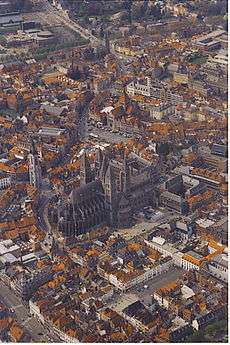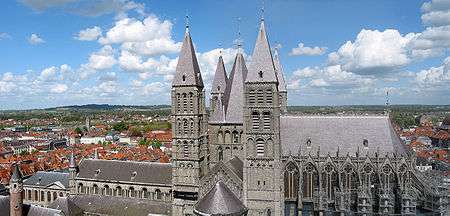Roman Catholic Diocese of Tournai
| Diocese of Tournai Dioecesis Tornacensis Diocèse de Tournai (French) Bistum Tournai (German) Bisdom Doornik (Dutch) | |
|---|---|
|
Aerial view of Tournai Cathedral | |
| Location | |
| Country | Belgium |
| Ecclesiastical province | Mechelen-Brussels |
| Metropolitan | Archdiocese of Mechelen-Brussels |
| Statistics | |
| Area | 3,796 km2 (1,466 sq mi) |
| Population - Total - Catholics |
(as of 2010) 1,291,850 904,905 (70%) |
| Information | |
| Denomination | Roman Catholic |
| Rite | Roman Rite |
| Established | 6th Century |
| Cathedral | Cathedral of Notre Dame de Tournai |
| Current leadership | |
| Pope | Francis |
| Bishop | Guy Harpigny |
| Metropolitan Archbishop | André-Joseph Léonard |
| Map | |
 The Diocese of Tournai, coextensive with the province of Hainaut | |
| Website | |
| Website of the Diocese | |
The Roman Catholic Diocese of Tournai is a diocese of the Latin Rite of the Roman Catholic church in Belgium. The diocese was formed in 1146, by the splitting of the diocese of Noyon and Tournai that had existed since the 7th century.[1] It is now suffragan of the archdiocese of Mechelen-Brussels.
History
As early as the second half of the 3rd century St. Piat evangelized Tournai; some writers represent him as the first bishop, but this cannot be proved. Towards the end of the 3rd century the Emperor Maximian rekindled the persecutions, and St. Piat suffered martyrdom.
The barbarian invasions began shortly afterwards. This lasted from the end of the 3rd century till the end of the 5th century. St. Remigius profited by the good will of the Frankish monarchy to organize the Catholic hierarchy in the north of Gaul. He confided the Diocese of Arras and Cambrai to St. Vaast (Vedastus), and erected the See of Tournai (c. 500), appointing as its titular Eleutherius.
It was probably its character of royal city which secured for Tournai this premature creation, but it soon lost its rank of capital by the departure of the Merovingian court. Nevertheless it kept its own bishops for nearly a century; then about 626 or 627, under the episcopate of St. Achar, the sees of Tournai and Noyon were united, retaining separate organizations. Tournai then lost the benefit of a privileged situation, and shared the condition of the neighbouring dioceses, such as Boulogne and Therouanne, Arras and Cambrai, where the same titular held both sees for five hundred years. It was only in 1146 that Tournai received its own bishop.

Among its bishops may be mentioned: St. Eleutherius (beginning of 6th century); St. Achar (626-27 — 1 March, 637-38); St. Eloi (641-60); Simon de Vermandois (1121–46); Walter de Marvis (1219–51), the great founder of schools and hospitals; Etienne of Tournai (1192–1203), godfather of Louis VII of France and minister of the queen; Andrea Chini Malpiglia (1334–42), cardinal and papal legate; Guillaume Fillastre (1460–73), chancellor of the Golden Fleece; Michel de Warenghien (1283–91), a very learned doctor; Michel d'Esne (1597–1614), the author of several works.
During the Spanish domination (1521–1667) the see continued to be occupied by natives of the country, but the capture of Tournai by Louis XIV in 1667 caused it to have as bishops a series of Frenchmen: Gilbert de choiseul duplessis praslin (1670–89); François de La Salle de Caillebot (1692–1705); Louis Marcel de Coëtlogon (1705–07); François de Beauveau (1708–13). After the Treaty of Utrecht (1713) the French were replaced by Germans: Johann Ernst, Count of Löwenstein-Wertheim (1713–31); Franz Ernst, Count of Salm-Reifferscheid (1731–1770); Wilhelm Florentine, Prince of Salm-Salm (1776–94).
The union of the see with Noyon and the removal thither of the seat of the bishopric had favoured the growth of the power of the chapter. The privilege possessed by the chapter under the old régime of being composed only of nobles and scholars necessarily attracted to it the most distinguished for birth and learning. Illustrious names of France and Belgium are inscribed in the registers of the archives or on the tombstones of the cathedral. The cathedral, 439 feet (134 m) long by 216 feet (66 m) wide, is surmounted by 5 towers 273 feet (83 m) high. The nave and transept are Romanesque (12th century), and the choir is primary Gothic, begun in 1242 and finished in 1325. Originally the boundaries of the diocese must have been those of the Civitas Turnacensium mentioned in the "Notice des Gaules". The prescriptions of councils and the interest of the Church both favoured these boundaries, and they were retained throughout the Middle Ages. The diocese then extended along the left bank of the Schelde from the Scarpe to the North Sea, with the exception of the Vier-Ambachten (Hulst, Axel, Bouchaute, and Assenede), which seem to have always belonged to the Diocese of Utrecht. The Schelde thus formed the boundary between the Dioceses of Tournai and Cambrai, cutting in two the towns of Termonde, Ghent, Oudenarde, and Tournai itself. The shore of the North Sea between the Schelde and the Yser was wholly included within the perimeter. On the other side of the Yser was the Diocese of Thérouanne, which bordered Tournai as far as Ypres. There began the Diocese of Arras, which bordered Tournai as far as the confluence of the Scarpe and the Schelde at Mortgne, France. This vast diocese was long divided into three archdeaneries and twelve deaneries. The archdeanery of Bruges comprised the deaneries of Bruges, Ardenbourg, and Oudenbourg; the archdeanery of Ghent, the deaneries of Ghent, Roulers, Oudenarde, and Waes; the archdeanery of Tournai, the deaneries of Tournai, Seclin, Helchin, Lille, and Courtrai.
In 1559 in order to wage more successful war against Protestantism, King Philip II of Spain obtained from Paul IV the erection of a series of new dioceses. The ancient Diocese of Tournai was divided, nearly two-thirds of its territory being taken away. The outlines of the archdeaneries of Bruges and Ghent formed the new diocese of Bruges and diocese of Ghent, and six parishes passed to the new diocese of Ypres. These conditions lasted until the beginning of the 19th century. The French Revolution created the Department of Jemappes, which in 1815 became the Province of Hainault, whose boundaries followed those of the Diocese of Tournai, after a concordat between the plenipotentiaries of Pius VI and the consular government of the republic. The Bishop of Tournai retained only two score of the parishes formerly under his jurisdiction, but he governed on the right bank of the Schelde a number of parishes which, prior to the Revolution, belonged to the Diocese of Cambrai (302), Namur (50), and Liège (50).
Bishops
To 1146
- 540 : St. Eleutherius of Tournai (Eleuthere)
- c. 549 and 552 : Agrecius
- 545 : Medardus
- Then jointly with Noyon
- ca. 626–ca. 638 : Acarius
- 641–660 : Eligius
- ca. 661–ca. 686 : Mummolenus
- Gondoin
- ca. 700 : Antgaire
- ca. 715 : Chrasmar
- ca. 721 : Garoul
- ca. 723 : Framenger
- ca. 730 : Hunuan
- ca. 740 : Gui et Eunuce
- ca. 748 : Elisée
- ca. 756/765 : Adelfred
- ? : Didon
- 769–ca. 782 : Giselbert
- ca. 798/799 : Pleon
- ca. 815 : Wendelmarus
- ca. 830/838 : Ronegaire
- ca. 830/838 : Fichard
- 840–860 : Immon
- 860–879 : Rainelme
- 880–902 : Heidilon
- 909 : Rambert
- 915–932 : Airard
- 936 - †936 : Walbert
- 937–950 : Transmar, Transmarus
- 950–954 : Rudolf
- 954–955 : Fulcher
- 955–977 : Hadulphe
- 977–988 : Liudolf of Vermandois
- 989–997 : Radbod I
- 1000–1030 : Hardouin
- 1030–1044 : Hugo
- 1044–1068 : Balduin
- 1068–1098 : Radbod II
- 1098–1113 : Baudry
- 1114–1123 : Lambert
- 1123–1146 : Simon of Vermandois
- Diocese split
1146 to 1500; bishops of Tournai
- 1146–1149 : Anselm
- 1149–1166 : Gerard
- 1166–1171 : Walter
- 1173–1190 : Everard
- 1193–1203 : Stephen of Tournai
- 1203–1218 : Gossuin
- 1219–1251 : Walter of Marvis
- 1252–1261 : Walter of Croix
- 1261–1266 : Johann I. Buchiau
- 1267–1274 : Johann II. d'Enghien
- 1275–1282 : Philipp Mus
- 1283–1291 : Michael von Warenghien
- 1292–1300 : Johann III. von Vassogne
- 1301–1324 : Guy of Boulogne (also Bishop of Cambrai)
- 1324–1326 : Elie de Ventadour
- 1326–1333 : Guillaume de Ventadour
- 1333 : Theobald of Saussoire
- 1334–1342 : André Ghini
- 1342–1349 : Jean IV. des Prés
- 1349–1350 : Pierre de Forest (also Bishop of Paris)
- 1351–1377 : Pierre d'Arbois
- 1379–1388 : Pierre d'Auxy
- 1380–1384 : Jean de West
- 1388–1410 : Louis de la Trémouille
- 1410–1433 : Jean de Thoisy
- 1433–1437 : Jean d'Harcourt
- 1437–1460 : Jean Chevrot
- 1460–1473 : Guillaume Fillastre
- 1474–1483 : Ferry de Clugny
- 1483–1505 : Schism
1500 to 1800
- 1505–1513 : Charles de Hautbois
- 1514–1518 : Thomas Wolsey
- 1519-1521?:[2] Josse van Clichtove
- 1519–1524 : Louis Guillard, bishop elect, tutored by Clichtove[3]
- 1524–1564 : Charles de Croÿ
- 1564–1574 : Guibert D'Ongnies
- 1574–1580 : Pierre Pintaflour
- 1580–1586 : Max Morillon
- 1586–1592 : Jean Vendeville (Jean Venduille)
- 1592–1614 : Michel D'Esne
- 1614–1644 : Max Villain
- 1644–1660 : François Villain
- 1660–1689 : Gilbert de Choiseul
- 1689–1705 : François de Caillebot de La Salle
- 1705–1707 : Louis-Marcel de Coëtlogon-Méjusseaume
- 1707–1713 : René de Beauveau (then Bishop of Toulouse)
- 1713–1731 : Johann Ernst von Löwenstein-Wertheim
- 1731–1770 : Franz Ernst von Salm-Reifferscheid
- 1770–1776 : Vacant
- 1776–1793 : Wilhelm Florentin von Salm-Salm (then Archbishop of Prague)
- 1793–1802 : Vacant
From 1800
- 1802–1819 : François-Joseph Hirn
- 1819–1829 : Vacant
- 1829–1834 : Jean-Joseph Delplanque
- 1834–1877 : Gaspart-Joseph Labis
- 1877–1881 : Edmond Dumont
- 1881–1897 : Isidore-Joseph-Victor du Rousseaux
- 1897–1915 : Carolus Gustavus Walravens
- 1915–1924 : Amédée Crooy
- 1924–1939 : Gaston-Antoine Rasneur
- 1940–1945 : Luigi Delmotte
- 1945–1948 : Etienne Carton de Wiart
- 1948–1977 : Charles-Marie Himmer
- 1977–2002 : Jean Huard
- 2003–present : Guy Harpigny
Notes
- ↑ Tournai {Doornik} (Diocese) [Catholic-Hierarchy]
- ↑ says he was tutor to Guillard; that he was actually bishop.
- ↑ In a sequence of events complicated by the English capture of Tournai in 1514, the young Guillard was nominated to the see in 1513, Wolsey was appointed administrator in 1514 and in 1515, 1517 and 1518 the current status apparently changed. An Anglo-French treaty of 1519 resolved the matter. Peter G. Bietenholz, Thomas Brian Deutscher, Contemporaries of Erasmus (2003), pp.151-2.
External links
| Wikimedia Commons has media related to Roman Catholic Diocese of Tournai. |
![]() This article incorporates text from a publication now in the public domain: Herbermann, Charles, ed. (1913). "article name needed". Catholic Encyclopedia. New York: Robert Appleton.
This article incorporates text from a publication now in the public domain: Herbermann, Charles, ed. (1913). "article name needed". Catholic Encyclopedia. New York: Robert Appleton.
Coordinates: 50°36′26″N 3°23′18″E / 50.607195°N 3.388198°E

